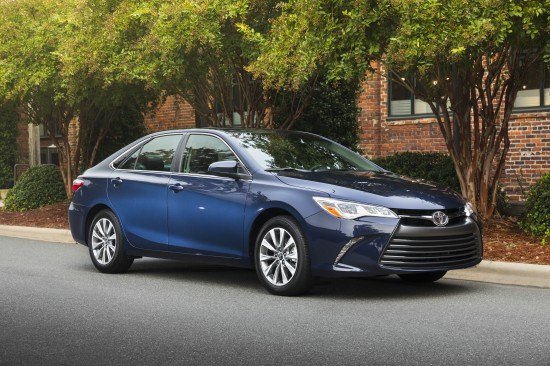America's Top 5 Midsize Cars Earn 7 Out Of Every 10 Midsize Car Sales
America’s five top-selling midsize cars have held an iron-fisted grip on their category for years, making it very difficult for interlopers to succeed in any meaningful way.
• Sonata & Malibu knocked out of January’s top five
• Midsize cars up 5.5% in January
• Top five own 69% of midsize market
Yet after earning more than seven out of every ten midsize sales in 2009 and 2010 – when the top five included the Camry, Accord, Altima, Fusion, and Malibu – the top five’s market share slid to 67% in 2011 and 64% in 2012. In 2011, the Hyundai Sonata supplanted the Chevrolet Malibu in the top five and didn’t let go in 2012, 2013, or 2014.
But then a return to the norm began, as the top quintuplet’s share grew to 66% in 2013 and 69% in 2014.
2015 started off similarly.
That car was not the Hyundai Sonata, nor was it the Chevrolet Malibu, the last two cars to join the CamAcoTimUsion in the top five on an annual basis.
Instead, the Chrysler 200, up 30% to 14,157 units in January, was America’s fifth-ranked midsize car, 1794 units ahead of the Hyundai Sonata (up 26% to 12,363), 2279 ahead of the Chevrolet Malibu (up 0.5% to 11,878), 4763 ahead of the Kia Optima (down 6% to 9394), and 7852 sales ahead of the Volkswagen Passat (up 1% to 6305).
And while total FCA/Chrysler Group midsize car volume slid 8% to 14,399 in January (as the 200 was not able to completely counteract the disappearance of 95% of the defunct Dodge Avenger’s January sales) and as Fusion volume slid 5%, the real story is the increased clout of the top five finishers. Their market share grew three percentage points from 66% in January 2013 and January 2014 and 67% in December 2014 to 69% in January 2015.
There are only a handful of sales leftover for many intermediate sedans which are marketed with mainstream pricing but sell in the kinds of numbers put up by premium cars. The Mazda 6, Subaru Legacy, and Volkswagen Passat combined for slightly less than 9% of the midsize car market in America last month. The aging Kia Optima, which slid 6% in a category which grew 5.5%, posted four consecutive years of improvement leading up to 2015. But the Optima earned only 6.5% of the market in its best year, a year in which GM’s declining Chevrolet Malibu claimed 7.8% of the midsize category.
Does that mean all hope is lost for the Optima, Passat, Legacy, 6, or any potential Mitsubishi sedan? Of course not all hope. But a number of factors – e.g. production capacity, reputation, loyalty, incentives – contribute to an even more precise alignment of stars that favours the major players maintaining their standing.
Timothy Cain is the founder of GoodCarBadCar.net, which obsesses over the free and frequent publication of U.S. and Canadian auto sales figures.
More by Timothy Cain
Latest Car Reviews
Read moreLatest Product Reviews
Read moreRecent Comments
- Slavuta CX5 hands down. Only trunk space, where RAV4 is better.
- Kwik_Shift_Pro4X Oof 😣 for Tesla.https://www.naturalnews.com/2024-05-03-nhtsa-probes-tesla-recall-over-autopilot-concerns.html
- Slavuta Autonomous cars can be used by terrorists.
- W Conrad I'm not afraid of them, but they aren't needed for everyone or everywhere. Long haul and highway driving sure, but in the city, nope.
- Jalop1991 In a manner similar to PHEV being the correct answer, I declare RPVs to be the correct answer here.We're doing it with certain aircraft; why not with cars on the ground, using hardware and tools like Telsa's "FSD" or GM's "SuperCruise" as the base?Take the local Uber driver out of the car, and put him in a professional centralized environment from where he drives me around. The system and the individual car can have awareness as well as gates, but he's responsible for the driving.Put the tech into my car, and let me buy it as needed. I need someone else to drive me home; hit the button and voila, I've hired a driver for the moment. I don't want to drive 11 hours to my vacation spot; hire the remote pilot for that. When I get there, I have my car and he's still at his normal location, piloting cars for other people.The system would allow for driver rest period, like what's required for truckers, so I might end up with multiple people driving me to the coast. I don't care. And they don't have to be physically with me, therefore they can be way cheaper.Charge taxi-type per-mile rates. For long drives, offer per-trip rates. Offer subscriptions, including miles/hours. Whatever.(And for grins, dress the remote pilots all as Johnnie.)Start this out with big rigs. Take the trucker away from the long haul driving, and let him be there for emergencies and the short haul parts of the trip.And in a manner similar to PHEVs being discredited, I fully expect to be razzed for this brilliant idea (not unlike how Alan Kay wasn't recognized until many many years later for his Dynabook vision).



































Comments
Join the conversation
No, but most readers would want to know it, fleet sales are not a good indicator.
I tried to look into the 200 on TrueDelta and oddly the car doesn't exist there, which is rather strange for a top 5 vehicle.